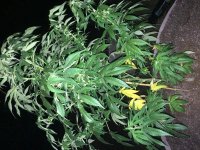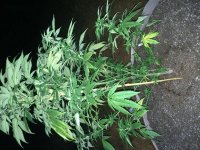Aint It Fresh
New member
Hey all, I regret that my first post on this wonderful site has to be executed with such a worried and heavy heart. As a long time lurker and first time poster of these forums, I trust the patrons enough that after all of the people I've asked in person with no satisfactory response, I look to you guys as my final hope in the rescue of my crop.
So, I am growing several plants outdoors, half of which are already transplanted into their final homes (200 gallon smart pots) and the other half are in their soon to be vacated 5 gallon pots. They are roughly 3 months old and were attained as clones in solo cups from a local guy. They are in a super soil-esque mix made by a local company, which several guys i know have given rave reviews. I am using the advanced line of Oregon's Only - Nectar For the gods (previously Harvest Moon) nutrients. I am PH'ing to 6.0-6.5 and feeding every other watering as per the feeding schedule on their site, as well as a weekly aerated compost tea. I transplanted with healthy doses of Great White mycos and azos beneficial bacteria by Extreme gardening directly on the roots and pot holes. I have a slight mite problem but I am dealing with that, and it is not one of my main concerns. I feel as if I am doing everything right, but I am still seeing sadness in my plants. The leaves are yellowing at an alarming rate, sometimes 6 to a dozen every couple days per plant, and they are starting to look pretty bare. They still have a few good months to veg out but I am worried that they won't make it that long because of all of the foliage loss. I am completely confused and have come to no conclusion as to what is causing my problem. I will post photos as needed or requested. Thank you guys in advance, I couldn't be more grateful for your taking time to read my novel of a post and hopefully providing me with a little insight. CALLING ALL VETERANS
So, I am growing several plants outdoors, half of which are already transplanted into their final homes (200 gallon smart pots) and the other half are in their soon to be vacated 5 gallon pots. They are roughly 3 months old and were attained as clones in solo cups from a local guy. They are in a super soil-esque mix made by a local company, which several guys i know have given rave reviews. I am using the advanced line of Oregon's Only - Nectar For the gods (previously Harvest Moon) nutrients. I am PH'ing to 6.0-6.5 and feeding every other watering as per the feeding schedule on their site, as well as a weekly aerated compost tea. I transplanted with healthy doses of Great White mycos and azos beneficial bacteria by Extreme gardening directly on the roots and pot holes. I have a slight mite problem but I am dealing with that, and it is not one of my main concerns. I feel as if I am doing everything right, but I am still seeing sadness in my plants. The leaves are yellowing at an alarming rate, sometimes 6 to a dozen every couple days per plant, and they are starting to look pretty bare. They still have a few good months to veg out but I am worried that they won't make it that long because of all of the foliage loss. I am completely confused and have come to no conclusion as to what is causing my problem. I will post photos as needed or requested. Thank you guys in advance, I couldn't be more grateful for your taking time to read my novel of a post and hopefully providing me with a little insight. CALLING ALL VETERANS














